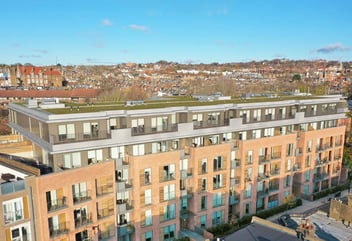As a property developer overseeing £50-100M GDV projects, you're well-versed in evaluating financing options. But have you ever looked beyond the headline interest rates from lenders to understand what your development financing truly costs?
When evaluating development finance, most conversations start with interest rates. A typical capital stack might include:
- Senior debt at 10.5% covering 60% LTV
- Mezzanine financing at 20% covering the 60-75% LTV band
This creates a blended rate of 12-14% - the figure that often drives initial decision-making. However, this headline rate only scratches the surface of your actual financing cost.

The true cost equation
The real cost of development finance encompasses multiple financial components that aren't immediately visible in interest rate discussions. For a typical £45M facility on a £75M GDV project over 24-months, these include:
- Arrangement fees
Traditional financing typically requires paying arrangement fees to both senior and junior lenders. A senior lender might charge 1% while a mezzanine provider often charges 3% or more. This represents nearly £800,000 in fees before construction even begins.
- Legal and costs
Each lender requires separate legal documentation, often with their own solicitors and specific requirements. This not only creates legal costs (typically £120,000+ for both sets) but also introduces complexity into your documentation and potential conflicts between different lenders' requirements.
- Monitoring and exit fees
Both lenders will charge separate ongoing monitoring fees and potentially exit fees. These combined costs typically amount to 1.2% of the facility - another £540,000 on a £45M facility.
- The time value of complexity
Perhaps most overlooked is the time value of managing a complex financing structure. Traditional multi-lender financing often requires 8-12 weeks to close, with each week of delay adding to:
- Extended land holding costs
- Potential cost inflation in materials and labour
- Missed market windows
- Extended project timeline
The effective rate reality
When all these costs are factored in, the effective rate on traditional development financing for a 24-month project is actually 18.1% per annum - significantly higher than the headline blended rate of 12.4%.
This differential represents a substantial impact on project returns, particularly in today's challenging
environment where margins are under pressure from multiple directions.
Alternative approaches
As the development finance landscape evolves, various financing structures are emerging to address different aspects of these challenges. Whole loan solutions, which provide unified financing across both senior and junior tranches, offer opportunities to streamline processes and documentation, potentially reducing administrative complexity.
While fee structures remain relatively consistent across the market, unified financing approaches can deliver operational advantages:
- Simplified documentation and covenant structures
- More predictable drawdown processes
- Aligned incentives across the entire capital stack
- Streamlined relationship management
The strategic considerations
When evaluating financing options, consider these key questions:
- What is the true all-in cost? Calculate all fees, including legal costs, monitoring charges, and the time value of extended approval processes.
- What is the operational burden? Consider the resources required to manage relationships with multiple lenders with potentially different priorities.
- What is the execution risk? Evaluate the probability of delays or complications arising from coordinating multiple lenders, particularly in challenging market conditions.
- What is the flexibility value? Consider how different financing structures might respond to changes in project timelines or market conditions.
Looking beyond the headline
Understanding the true cost of development finance requires looking beyond the headline rates to consider the complete financing picture. This holistic approach to evaluating financing options can help you make more informed decisions that optimize both financial outcomes and operational efficiency.
As development margins face continued pressure, this comprehensive view of financing costs becomes increasingly important to project success.
Next in this series: One loan to rule them all: Simplifying residential development financing - exploring how unified financing structures streamline the development process.
Visit the Borrowing section to find out more about the development finance loans Shojin offers


















